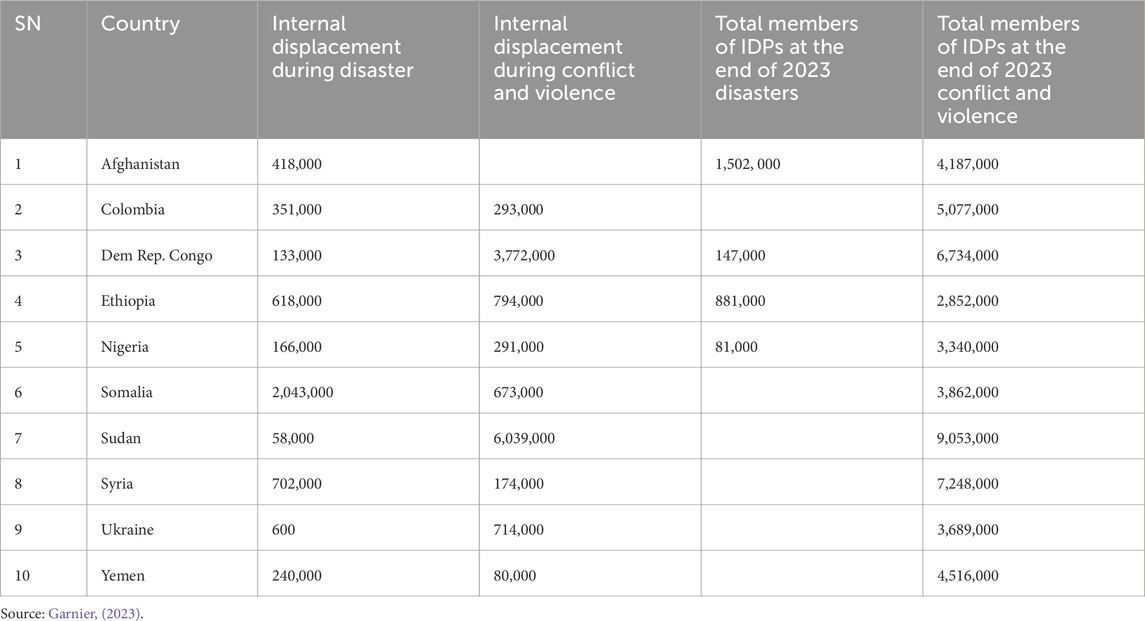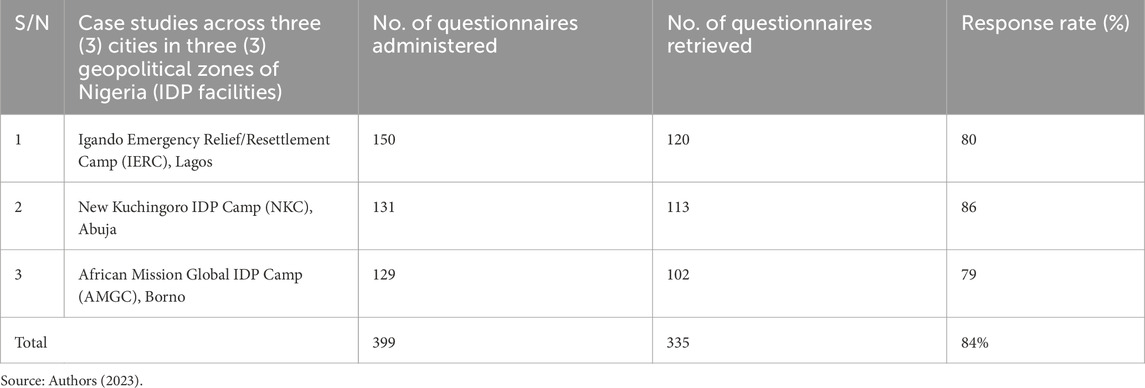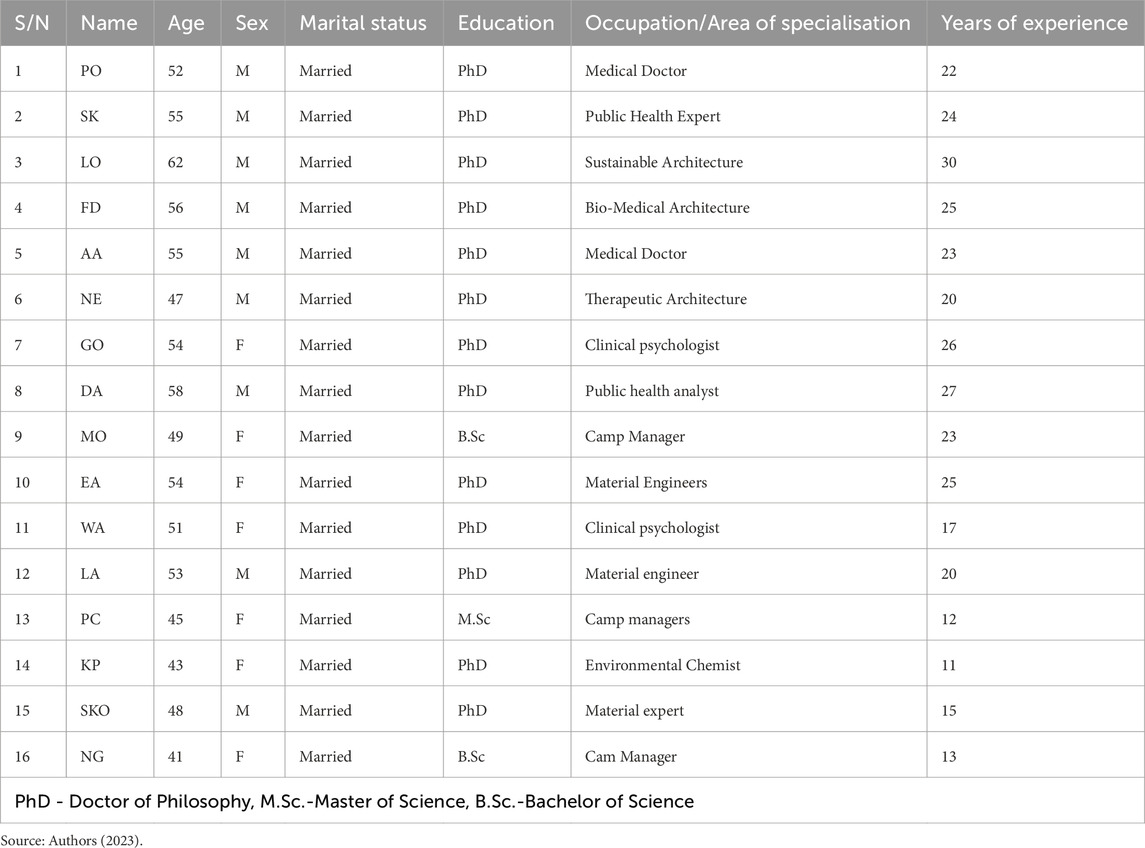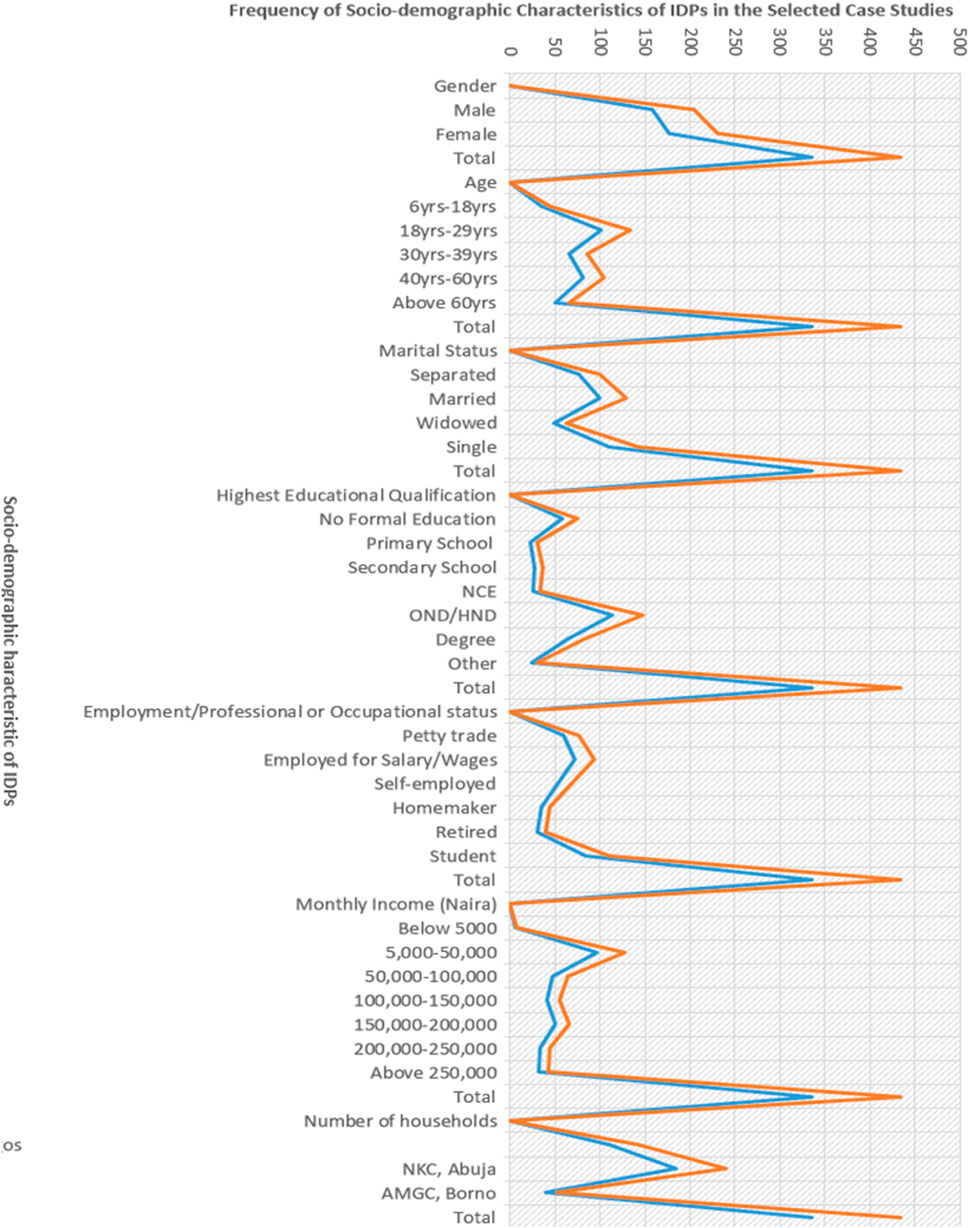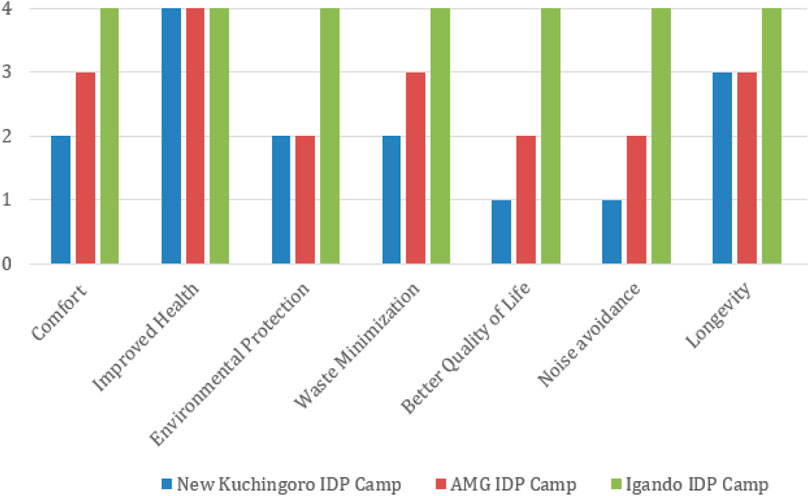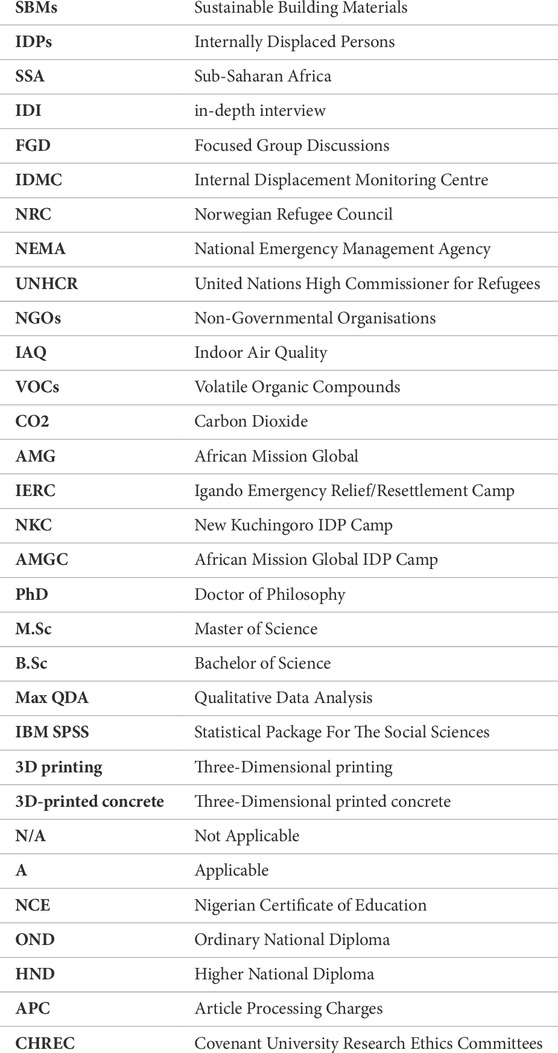- Department of Architecture, Covenant University, Ota, Ogun State, Nigeria
There are 70.8 million Internally Displaced Persons in the world. In Sub-Saharan Africa Nigeria has 16.5 million people and the highest displacement rate. IDPs in Nigeria need shelters primarily to mitigate homelessness and improve their quality of health through sustainable building materials (SBM) used in design and construction. The study aimed to investigate SBMs and their impact on the health/wellbeing of Displaced Persons in IDP facilities to promote the health benefits of SBMs. Assess the SBMs used to design IDP facilities in the three case studies; ascertain the health/wellbeing components of the SBMs; and analyse the impact of SBM on displaced persons’ health/wellbeing. The study used the mixed (quality and quantitative) research method while leveraging the case study design. The research philosophy is pragmatism, and the research paradigms are interpretivist and constructivist. The data collection instrument includes a questionnaire survey for quantitative data, an in-depth interview guide, and an observation schedule (direct and participant). The findings reveal that SBMs have some health benefits, SBMs have impacts on the IDPs’ wellbeing, and SBMs can be sourced locally. According to the study, SBMs can reflect the people’s culture, making IDPs homely, happy and comfortable with positive psychosocial impacts that may improve their mental health.
1 Introduction
According to Rupiya (2020) and Baquedano et al. (2021), there are 70.8 million IDPs Globally. Sub-Saharan Africa (SSA), with 16.5 million, has the highest displacement rate within the African region. Nigeria has the highest rates of IDPs in Africa. The Internal Displacement Monitoring Centre (IDMC) and the Norwegian Refugee Council (NRC) reported that Nigeria has 33.3 per cent of IDPs in Africa and 10 per cent of IDPs worldwide (IDMC, 2018a; IDMC, 2018b). Internal displacement is a reoccurring phenomenon in Nigeria caused by conflict, violence, natural disasters and human rights violations (Olanrewaju et al., 2019; Adejumo et al., 2022). The most vulnerable people in the Nigerian population are IDPs (Kamta, Schilling and Scheffran, 2020). Okon (2018) and Ahmed et al. (2021) explain that the sudden rise in IDPs in Nigeria is due to Boko Haram attacks, Fulani herds-men invasions, oppressive insurgency operations, and inter-communal conflict. National Emergency Management Agency (NEMA) reported that flooding caused by heavy rainfall across Nigeria displaced over two million people still lacking permanent residences (Shi et al., 2019; Ekoh et al., 2022; Neu and Fünfgeld, 2022). Most displaced persons in Nigeria live in makeshift buildings (Ekhaese et al., 2021). These displaced persons find refuge in close communities. They face issues such as socio-economic, political, health and environmental problems, loss of livelihoods, insecurities, inadequate food and consumable water, overcrowding, substandard living, sanitary conditions, racism, sexual assaults, underage labour marriage and pregnancy, stigmatisation and other forms of social rejections in their host communities (Mucherera and Spiegel, 2022). Recent findings indicate that the displacement affected several farming communities, leading to an intense humanitarian crisis. Unfortunately, there are no government-established camps for the IDPs in the south-south, southeast and south-west zones of Nigeria (Aleyomi and Nwagwu, 2023). Against this background, Nigeria is in dire need of government-established IDP camps across the six geopolitical zones. Therefore, this research investigates SBM for IDP facility and their impact on the IDPs’ health/wellbeing with the following objectives: assess the SBM used in the design of IDP facilities in the three case studies; ascertain the health/wellbeing components of the SBM and analyse the impact of SBM on IDPs health/wellbeing. The investigators conducted a systematic and integrative review in the next section to properly situate this study in the current literature. The next session reviewed current literature relevant to the subject under three sub-themes drawn from the objectives. The material and method section highlighted the strength of mixed methods (qualitative and quantitative) under several sub-headings and why it is the best methodology for this study. The findings and results section presents the findings and results in chronological order according to the sequence of the objectives. The authors presented results in charts, tables and figures. However, the conclusion reveals the current situation of IDPs, and all hands must be on deck to create a resilient and sustainable environment for them. The limitation section outlines a few constraints observed in the study.
2 Literature review
According to Akujobi and Awhefeada (2021), IDPs are persons or groups of people who have not surpassed a state border and compelled to leave their abode or residence to avoid their rights violated due to armed conflict, violence, natural and artificial disasters. IDPs depend on the government for protection from violence and persecution (Adesote and Ajayi, 2021). IDPs are the most vulnerable persons and face challenges such as the loss of loved ones, properties, jobs, livelihood and injuries (Bradley, 2023). According to Folayan et al. (2023), there were 53.2 million IDPs affected by armed conflict, violence and violation of human rights in 2021. These persons are protected and helped by UNHCR to prevent future displacement by coordinating an operational delivery role and providing life-saving aid and solutions for displaced communities, as shown in Table 1 and Figure 1 (Internal Displacement section, 2020).
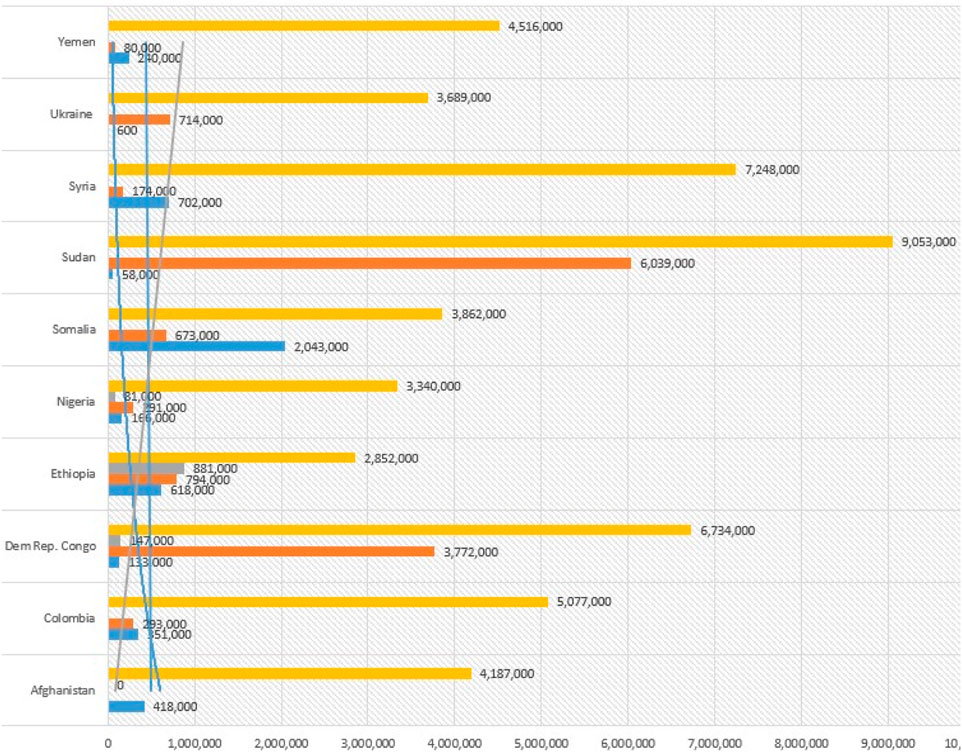
Figure 1. IDPs protected/assisted by UNHCR in Millions in 2022; Source: Garnier, (2023).
2.1 Residential facility- IDP camp
Shehu (2021) claimed that shelter is a human right and humans deserve a secure and comfortable home. Idowu, Danlami and Ohadugha (2022) believe that shelters and other facilities - electricity, toilets, water, security, health services, and recreational-are primary facilities in an IDP camp. The government, NGOs and international organisations consciously seek to provide shelter for IDPs, which is either low quality or inadequate (Earle et al., 2020; Schimmel, 2022). To solve this problem, we need to construct IDP camps with SBM (Burns et al., 2018). Charlesworth and Fien (2020) highlighted that adequate shelters should cater to all displaced people, such as children, youths, teenagers, adults, the elderly, and pregnant and breastfeeding mothers. IDP camps consist of housing units with convenience, kitchens and living quarters (Seenapatabendige and De Silva, 2023). Resettlement camps should meet the UNHCR standard of approximately 20,000 IDPs (Szilágyi, 2021).
2.2 SBMs, their use and health benefits
Khoshnava et al. (2020) explained that SBMs containing non-harmful chemicals can improve human health and Indoor Air Quality (IAQ). SBMs are organic, safe, reusable, and sustainable composite materials that enhance quality of life. SBMs can lower harmful environmental and human health effects (Wu et al., 2022). SBMs are non-toxic, renewable, eco-friendly materials that improve human health/wellbeing quality. Using hybrid SBMs can improve human health in and outdoors (Islam et al., 2022; Mehrizi et al., 2023). It can reduce VOC effects on human health by about one-third, according to the life cycle inventory using SimaPro software (McArthur and Powell, 2020; Al-Mudhaffer, Saleh and Kadhum, 2022). Li et al. (2023) agreed that SBMs for reclaimed decking and roofing withstand the elements and require less management. Sustainable building residents experience significant health improvement, stress levels and overall quality of life due to improved interior design features such as lighting, thermal conditions, ergonomic features and air quality. Similarly, using water-saving plumbing equipment minimises water waste, eases shared water supply burden and permits water recycling and alternative water source use. SBMs improve urban biodiversity and protect the ecosystem (Pearlmutter et al., 2020). SBM designs and technologies reduce construction, demolition waste and carbon emissions. From an economic perspective, SBMs save 30 per cent on energy consumption, cost, energy and water efficiency (Elshoubaky et al., 2023). Improved thermal and visual comfort in sustainable buildings can enhance human productivity levels and reduce absenteeism (Elnaklah, Walker and Natarajan, 2021; Durdyev et al., 2022). Visual comfort in a building space is associated with illuminance distribution, which affects psychosocial wellbeing and productivity (Day et al., 2019; Tabadkani et al., 2021). SBMs reduce consumption and maximise resources utilised efficiency (Ogunmakinde, Egbelakin and Sher, 2022). SBM application in new construction can reduce buildings’ environmental impacts (Andersen, Ravn and Ryberg, 2022).
2.3 Benefits of SBMs in the design and construction of IDP camp
Adeniyi et al. (2021) explained that SBMs are recommended for low-cost building construction because they are cost-effective, readily available, adaptable, energy efficient, reduce waste and CO2 emissions, enhance community economy, impact psychosocial wellbeing/health, promote culture and are harmless to the environment. SBMs are fast-growing renewable resources in foundations, flooring, roofing, wall cladding, windows, and door construction. SBMs are readily available with a low carbon footprint that has a positive health impact on the IDPs. We use SBMs such as recycled paper, glass, plastic, sandbags, bottles and metal to reduce waste land pollution and conserve natural resources. SBMs are durable materials and reduce environmental pollution. SBMs reflect the culture of the IDPs, making them happy, comfortable and homely.
3 Method and materials
The Investigators designed the methodology section of this study to address the three research questions. The study investigates SBMs and their impact on IDPs’ health/wellbeing to promote health benefits. The following questions are: What are SBMs used to design IDP facilities in the three case studies? What are the health/wellbeing benefits of SBMs? What are the effects of SBMs on the IDPs’ health/wellbeing in the case studies? The IDP camps are physical and social units. Therefore, the study should measure the facilities’ SBMs and the impact on Occupants’ health/wellbeing. The investigators consider the viability of collecting data, sampling technique, observation simplicity or data availability. The research used a case study design that employed mixed research methods (quantitative and qualitative), as shown in Figure 2. This mixed-method approach engages data triangulation, allowing reliable responses to the research questions. The study population are IDPs in the three (3) case studies across three (3) geopolitical of Nigeria - Lagos (Igando Emergency Relief/Resettlement Camp), Abuja (New Kuchingoro IDP Camp) and Borno (African Mission Global - AMG IDP Camp). The study areas are Lagos, Abuja, and Borno, Nigeria. The population elements are IDPs in the Northeast, North-Central and South-West, Architects that design the three IDP camps, and Material/Health experts in the three geopolitical zones.
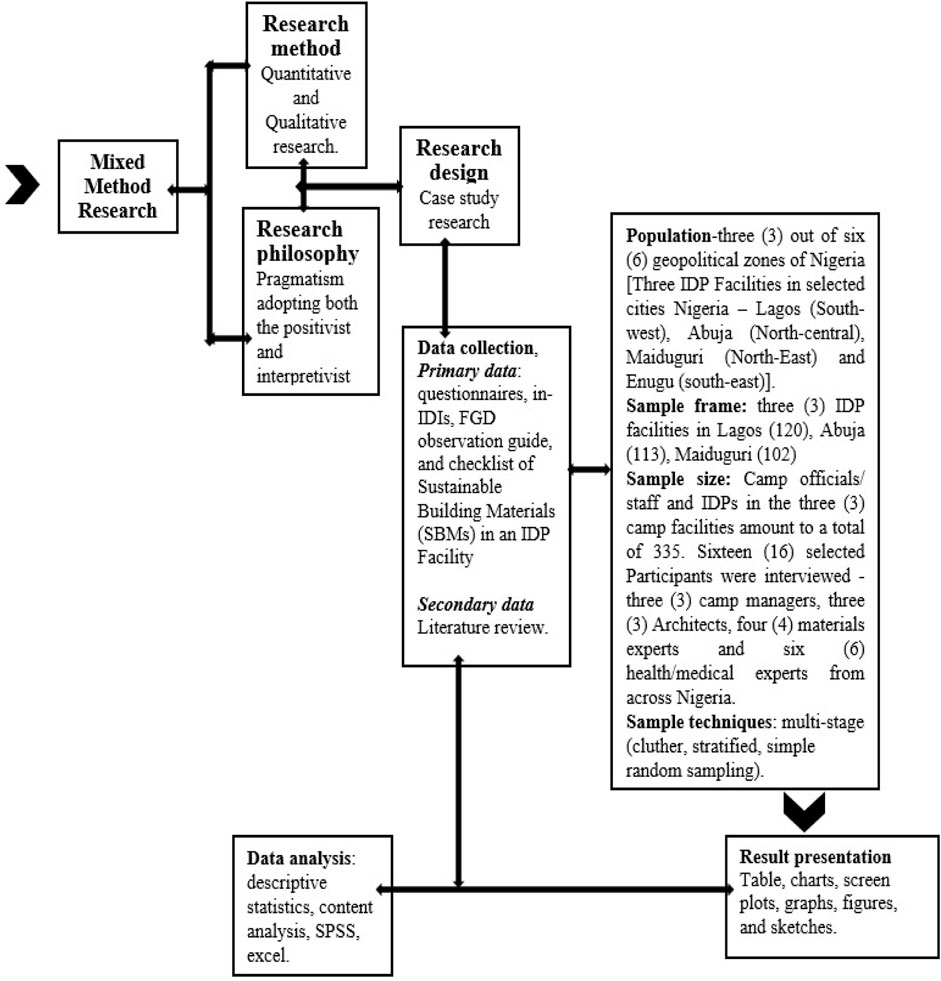
Figure 2. Structure of the research methodology diagram; source: Eghosa N. Ekhaese, Praise O. Akindoyin and Ibrahim A. Mohammed (2023).
3.1 Research design
This study is about SBMs for IDP facilities and their Impact on IDPs’ Health/Wellbeing. The users are displaced men, women and children. Therefore, the research design is a case study of three existing IDP Camps in Nigeria. The investigators sourced the data using questionnaires, an IDI) guide, Focused Group Discussions (FGD) and an observation schedule from three case studies. The investigators used an observation schedule to collect the health/wellbeing components of SBMs in the selected IDP camps. The respondents during interviews (IDI and FGD) were the camp manager, volunteer teacher, architect, Material/health experts and IDPs. The researchers analyse the impact of IDP camp SBMs on residents’ health/wellbeing using interviews and questionnaire data. According to George and Adelaja (2022), there are 3.2 million IDPs in Nigeria. However, the total population of IDPs covers three case studies in Nigeria, which is 180,492.
3.2 Sampling technique
Sampling techniques for collecting data are limited to analysing the entire population (Taherdoost, 2016; Noor, Tajik and Golzar, 2022). The suitable sampling technique for this study is mixed (probability and non-probability) method sampling, is a multistage (stratified, purposive and random sampling methods). The stratified sampling method involves the states that have registered IDP camps in Nigeria-Lagos in the south-west zone, Abuja in the north-central zone and Borno in the northeast zone. A purposive sampling includes a male child, male adult, male teenager, male youth, widower, female child, female adult, female teenager, female youth, widow, orphans, pregnant women and elderly persons in the camps. Simple random sampling involves selecting IDPs as questionnaire respondents without bias (Roberton et al., 2017). Uakarn et al. (2021) stated that Yamane developed the formula to determine the sample size for an identified population.
The formula is n = N/1 + N (e)^2 (1)
Where N = population size, n = required sample size and
e = level of precision (0.05 for 5% of true value).
The total population of IDPs in Lagos, Abuja and Borno, Nigeria is 180,492. The study sample size for IDPs is determined using this formula:
n = 180,492/1 + 180,492 (0.05) ^2 (2)
Then n = 180,492/452.23,
Therefore n = 399.11.
The investigators gave about 399 IDP questionnaires to fill out.
3.3 Data collection
The unit of data collection is IDPs, which are male (children, teenagers, youth, adults and widowers), female (children, teenagers, youth, adults and widows) orphans, pregnant women and elderly persons. Data collection instruments for this research are an IDI guide for architects, material/health experts, and IDP camp operators, questionnaires for the IDPs, and an observation guide to identify architectural features in the selected IDP camps. The investigators extracted data from field observations, a checklist, a survey questionnaire, and an IDI and FGD guide. The authors distributed three hundred and ninety-nine (399) questionnaires among the IDPs within the selected case studies, as presented in Table 1. Out of 399 questionnaires distributed, the researchers retrieved 335. The authors used a semi-structured questionnaire to analyse the impact of SBM on displaced persons’ health/wellbeing. The breakdown of the number of questionnaires administered and the responses are in Table 2. These questionnaires were deliberately to be completed by IDPs. To gather information on SBMs and their impacts on the IDPs’ health/wellbeing. To analyse the SBMs’ impact on IDPs’ health/wellbeing, the investigators conducted a survey using a semi-structured questionnaire. Four (4) research assistants (two co-authors and two M.Sc. students of Architecture) undertook the data gathering exercise for four months–morning and evening, during the weekend-Fridays - Sundays for 8 weeks (from March 3 to 5 May 2023).
According to Table 2, Igando Emergency Relief/Resettlement Camp (IERC), Lagos, had an 80% response rate; New Kuchingoro IDP Camp (NKC), Abuja, returned 86% of the questionnaires completed. African Mission Global IDP Camp (AMGC), Borno, had a 79% response rate. Therefore, sample collection details for analysis revealed 399 samples were collected, and 335 were submitted/received for analysis across the study area. However, the accepted level or success rate was 84%, inferring there was 16% rejection.
3.3.1 Expert source and recruitment procedure
Participants for the qualitative data were three camp managers - one each from the three IDP facilities selected for the study, architects from Covenant University, Ota, Nigeria and material and health experts from the universities across the three cities (Lagos, Abuja and Borno) used as case studies (IDP Facilities) who signed the consent form. The investigators selected sixteen (16) of them for IDI, and the interview lasted 45–60 min. The purposive selections were three (3) architects, four (4) materials experts, six (6) health experts and three (3) host officials from the three IDP camps used as case studies. Following the recommendation in qualitative research to ensure a suitable representation of the lived experiences and diversity of the experts, the investigators used a purposive sampling method with six criteria: age, Gender, marital status, education, occupation and years of experience, as shown in Table 3 below.
3.4 Data analysis
The investigators analysed the qualitative data derived through IDIs, FGDs and observation guides using content analysis and Max QDA (Qualitative Data Analysis). We presented the result using a descriptive approach using tables. They also analysed the quantitative data from survey questionnaires using IBM SPSS v26 and presented the findings using tables, graphs, and figures. The investigators transcribed the interviews and coded the direct quotes under the objectives themes-assessed the SBMs used to design IDP facilities in the three case studies, ascertained the health/wellbeing components of SBMs and analysed the impact of SBMs on IDPs’ health/wellbeing. The researchers stored the data in a data bank and repository for other researchers to access based on request.
4 Finding and results
The study investigates the impact of SBMs on the health/wellbeing of IDPs to promote the health benefits of SBMs. The investigators presented quantitative and qualitative data retrieved serially according to the arrangement of the research objectives.
4.1 The results of the assessment of SBMs used to design IDP facilities in the three case studies
SBMs are produced and used to minimise, maintain or improve the quality of life and built environment impact (Sahlol et al., 2021). These materials can protect the built environment by reducing the building’s carbon footprint. SBMs promote a cleaner Earth and a future of sustainability while being aesthetically appealing and efficient (Bungau et al., 2022). SBMs are from low environmental impact/renewable resources, are life-cycle durable, have a manufactured/used smaller footprint and have easy end-of-life break (Shayegan, Bahri and Haghighat, 2022). Some can be human-made materials designed to preserve natural resources and are made from renewable resources to meet supply and demand. We use SBMs in the sustainable construction and design of healthy camp environments for IDPs already facing all kinds of psychosocial stresses and depression. For this study, the investigators assessed SBMs used to design IDP facilities in the three case studies in Nigeria. Examples of SBMs used across the three geopolitical - South-West (Igando Emergency Relief/Resettlement Camp-IERC, Lagos), North-Central (New Kuchingoro IDP Camp-NKC, Abuja) and North-East (African Mission Global IDP Camp-AMGC, Borno) to design IDP facilities are in Table 4. The common SBMs used across the three case studies buildings are wood and corrugated zinc roofing sheets. However, from the literature, twenty (20) SBMs were identified for a sustainable future as follows:
1. Bamboo is an SBM that is a renewable, flexible and versatile type of grass with strength similar to wood (Xu et al., 2022). Bamboo application in construction projects includes supporting concrete, scaffolding, roofing and building other structures. 2. Recycled plastic is a renewable resource used as plastic sheets, bricks and lumber. 3. Laminated timber is prefabricated timber with a higher strength and water resistance, potentially replacing steel and concrete (Giordano, Derikvand and Fink, 2023). It has a lower carbon footprint than steel and concrete, supports beams and columns, and is used in roofing and flooring (Chai et al., 2022).
4. Stone is an SBM that occurs naturally on the earth with no factory production and low CO2 emissions, and it is for home furnishings, such as titles and countertops. Stone is durable, low maintenance, versatile and produces little waste when used in construction projects (Kerr et al., 2022). 5. Cob is a mud mixture made from natural materials such as soil, straw, sand and lime (Yemesegen and Memari, 2023). Cobs are for residential building construction or as a replacement for concrete structures. Cobs are inexpensive and produce less CO2 than concrete. 6. Cork is a renewable, recyclable resource and an eco-friendly replacement for traditional insulation. It is SBM for insulating homes and other buildings (Ata-Ali et al., 2021). 7. Adobe is a SBM from the earth and takes less energy to produce (Olacia et al., 2020). It is a clay and straw mixture to make bricks for homes and other structures. 8. Reclaimed wood is restored waste wood during a deconstruction project. Reclaimed wood is used to furnish and decorate new projects and deconstruct lumber from older structures while preserving its integrity and natural beauty (Asa et al., 2022). 9. Precast concrete is a factory with low CO2 emissions. It is made in exact measurements and shipped to the construction site for bridges, foundations, parking garages, and sometimes entire buildings. 10. Mycelium is an organic and renewable resource with thin fibres from fungi that run underneath the ground as roots. When harvested and dried, mycelium becomes a durable, water, mould and fire-resistant building material that can combine with sawdust and demolition waste to create bricks for building structures (Al-Qahtani, Koç and Isaifan, 2023; Muiruri et al., 2023). 11. Sheep’s wool is a renewable, non-toxic, mould-resistant and natural resource harvested from animals to insulate buildings (Mann et al., 2023). 12. Pollution-absorbing brick is a double-layered brick with porous blocks that allow air through as it filters out pollutant particles. It neutralises CO2 emissions. Pollution-absorbing bricks are SBM and an air-filtering alternative to earth bricks (Mogas-Soldevila, 2023). 13. 3D-printed concrete is a more sustainable and viable alternative to concrete. It involves using 3D printing for the production of sustainable concrete. 3D-printed concrete allows contractors to digitally design any shape and use concrete to print it (Jipa and Dillenburger, 2022). 14. Cordwood is an SBM that uses stacked short logs (firewood) with Cob or mortar in between to build a wall. The cordwood technique is used in homes and provides a rural finish to the structure. Cordwood offers natural insulation and saves energy and money (Švajlenka and Kozlovská, 2021). 15. Rubber tyres are recycled SBM with durability, flexibility and insulation properties. Sustainability-focused homes (Earthship homes) use recycled tyres filled with sandbags as insulation. Rubber masonry block production uses recycled tyres (Karimi et al., 2023). 16. Newspaper wood is recycled paper waste turned into wood via innovation and advanced technology for construction projects, such as furniture and home décor (Abd El-Sayed, El-Sakhawy and El-Sakhawy, 2020). 17. Plant-based polyurethane rigid foam is an improved eco-friendly insulator used in homes and commercial buildings. It uses a mixture of bamboo, hemp and kelp as wall insulation, furniture and surfboards (de Oliveira et al., 2022). 18. Straw Bales are a renewable resource used as insulation. It is a SBM used for construction in several centuries. Straw bales, when protected from moisture, can last for years as insulation (Koh and Kraniotis, 2020). 19. Recycled glass is SBM used as a mixture in construction projects to imitate natural aggregates such as sand, gravel and crushed stone. It is also used by cement makers in their mixture (Nedeljković et al., 2021). 20. Recycled steel is a renewable SBM that has an unlimited life cycle and can retain its quality and durability. When used as a building framework and structural support, less energy consumption and reduced the project’s carbon footprint (Kim and Kim, 2020).
4.2 Result of ascertaining the health/wellbeing components of the SBMs
In Table 5, wood containing microfibril and corrugated zinc sheets containing zinc are the commonly used SBMs with health/wellbeing components used across all three selected IDP facilities. Wood regulates and boosts respiratory sensitivities to improve IDP’s sense of wellbeing and enhance recovery. Zinc’s anti-inflammatory properties can relieve health conditions such as acne, rosacea, etc., to improve the health/wellbeing of the IDPs. In FGDs with some IDPs, the findings suggest that, in most cases, the built environment of camp facilities has a significant effect on the health/wellbeing of surveyed IDPs. Eighty-three per cent of them reported that their health/wellbeing is not the same now as before their displacement. They said,
“In our formal residence, my children are always falling sick, and every time we treat malaria, cold, cough and cata since we have been here in this camp for the past year now, my children have not been sick”. (IDPs, FGD: 2023).
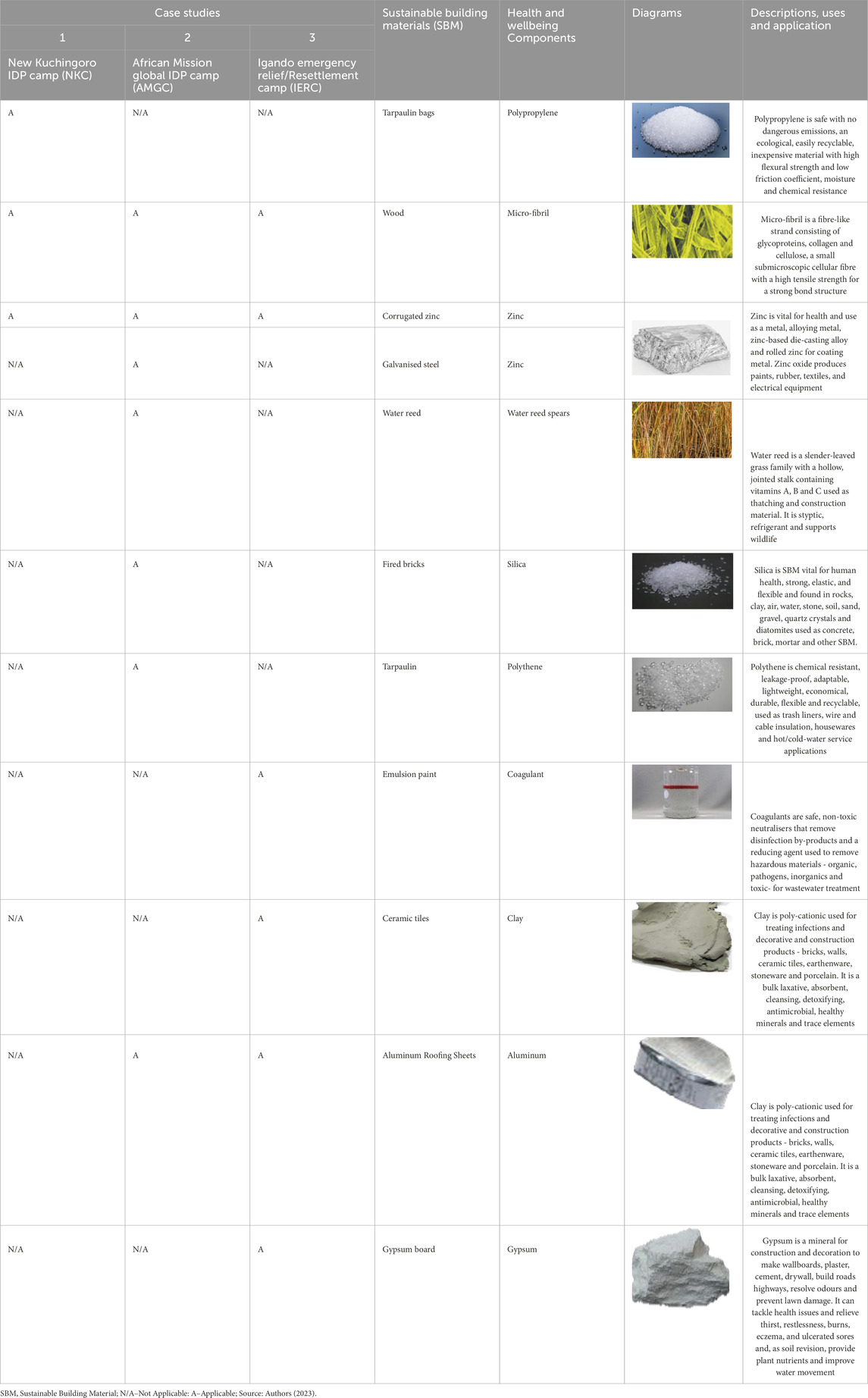
Table 5. Shows the health and wellbeing components of the SBM used in the three selected IDP facilities.
When asked the reason for their improved health/wellbeing. They traced it to the IDP camp environment’s enhanced indoor and outdoor air quality.
“According to the IDPs, the kind fresh air and clean environment and trees we have in this camp do not allow us to suffer any smell, sweat, dust, smoke, insect bite and even sickness”.
(IDPs, FGD: 2023)
“Since thermal comfort affects sleep quality and cardiovascular and respiratory health, careful consideration should be given to choosing SBMs that can control moisture and temperature levels. Wood contains a wellbeing component known as micro-fibril, which impacts and regulates humidity and respiratory functions of human health/wellbeing”.
(Biomedical Architect, IDI: 2023)
“The rising prominence of wellbeing building standards makes SBM a core consideration. Increased awareness of the impact of SBM on health, wellbeing and productivity means that building for wellbeing will soon become a watershed. SBM will be at the forefront of research and improve the longevity of occupants. For instance, the Gypsum board contain a health component called ‘gypsum’ which tackles health issues and relieves thirst, restlessness, burns, eczema, and ulcerated sores and as soil revision, provides plant nutrients, and improves water movement”. (Architect, IDI: 2023)
Many sustainable products have a feature of long-term usage in common. Using a product for longer will impact the environment, human health/wellbeing, and the wallet. For instance, one may often want to buy what is available, but the wiser decision to save money is to invest in a long-term material product that can be durable for many years.
(Camp Manager, IDI: 2023)
4.3 Result of analysing SBM impact on IDPs’ health/wellbeing
SBMs address environmental challenges and promote a more sustainable future for the construction industry. As the global population grows and urbanisation expands, the demand for buildings and infrastructure rises exponentially. However, this rise in construction has a significant effect on the environment - resource depletion, pollution and greenhouse gas emissions. In this context, SBMs offer a solution by reducing the environmental impact on human health/wellbeing while improving building efficiency, durability and healthiness. Therefore, objective three (3) analyses SBM impact, focusing on IDPs’ health/wellbeing benefits across the three selected case studies using semi-structured survey questionnaires distributed in Table 4 and ID1. SBMs impact IDPs’ health/wellbeing in several aspects, such as environmental protection, comfort, improved health, better quality of life, waste minimisation, Noise avoidance and longevity.
4.3.1 Impact on environmental preservation
Using SBMs in construction projects can reduce the ecological footprint, conserve natural resources and mitigate climate change. SBMs promote healthier indoor environments, resulting in improved health and productivity. In an IDI, an architect said
“SBMs are vital for their positive impact on environmental preservation due to low-carbon or carbon-neutral materials. Engaging SBMs in construction projects can significantly reduce building carbon footprint, as these materials require less energy consumption and produce fewer greenhouse gas emissions during manufacturing”. (Bio-medical architect, IDI: 2023)
4.3.2 Impact on comfort (thermal and acoustic)
SBMs enhance thermal and acoustic comfort within buildings to improve occupants’ comfort. SBMs complement biophilic design principles and connect occupants with nature. SBMs such as gypsum board, living walls, and natural light create a sense of harmony and enhance IDPs’ wellbeing within the camp. According to some experts
“Sawdust exhibited moisture absorption and desorption capabilities, making it a potential alternative for moisture buffering applications, which provide thermal comfort that impacts IDPs health/wellbeing”. (Material expert, IDI: 2023)
4.3.3 Impact on health/wellbeing
SBMs contribute to the health/wellbeing of IDPs, fostering a safer and more comfortable living environment by ensuring a healthier indoor environment free from harmful substances. According to an IDI
“Studies have demonstrated a connection between SBMs used in a building and occupants’ psychosocial health/wellbeing. However, using SBMs has a possible impact on psychosocial wellbeing. For instance, using wood in the interior has proven to be sustainable with impact on human psychosocial health”. (Clinical psychologist, IDI: 2023)
“SBMs have lower toxic emissions, which have health advantages and policy initiatives impact. SBMs impact health/wellbeing as they are used to construct healthier buildings for better IDPs mental wellbeing”. (Therapeutic architect, IDI: 2023)
4.3.4 Impact on better quality of life
Working and living in a building constructed with SBMs could improve productivity, job performance and overall quality of life. Similarly, several studies have reported that SBMs help occupants perform better while reducing stress. The healthier the environment, the better the quality of life. Following IDI, a medical doctor said
“Research shows that occupants of buildings constructed with SBMs have higher cognitive function, higher crisis response, higher applied activity level, higher goal make decisions, higher focused activity level, higher task attention span, fewer sick-building symptoms such as respiratory problems, fatigue and skin irritations, higher sleep quality and better quality of life”. (Neurologist, IDI: 2023)
4.3.5 Impact on reduce waste minimisation
SBMs address the issue of construction waste by using recycled or salvaged materials to divert waste from landfills and decrease the need for new raw materials. Using SBMs to design buildings ensures easy disassembling and repurposing at the end of their life cycle to reduce waste generation.
4.3.6 Impact on noise avoidance
Noise can have a significant impact on a person’s wellbeing. Research reveals that exposure to prolonged/excessive noise may cause health/wellbeing concerns such as stress, poor concentration, productivity losses, communication difficulties and fatigue from lack of sleep, cardiovascular disease, cognitive impairment, tinnitus and hearing loss. SBMs have good thermal insulation properties and sound-absorbing performances, which are effective for impact sound insulation. A participant during an IDI revealed that
“Noise pollution has several effects on human health/wellbeing, including poor learning performance, potential hearing loss, anxiety, stress and insomnia. However, SBMs have sound absorption efficiency. SBMs, such as light earth ceramic, contain a wellbeing component called ‘clay’ with less carbon-based acoustic materials that absorb noise and impact IDPs’ wellbeing”. (Public health analyst, IDI: 2023)
4.3.7 Impact on longevity
SBMs allow the built environment to have a direct impact on wellbeing. SBMs can boost buildings’ air quality/emissions and thermal and damp conditions with positive effects on health and improve the life–expectancy ratio, which impacts longevity. An engineer said
SBMs can help with air purification by reducing occupants’ exposure to chemicals linked to indoor health/wellbeing concerns, such as sick building syndrome, headaches, asthmatic reactions, and infectious and respiratory diseases that positively impact IDP’s longevity.
(Material engineer, IDI: 2023)
4.3.7.1 Socio-demographic analysis
From Figure 3, the study’s result represents an educated population, with most respondents having completed higher education ranging from NCE at 8%, OND/HND at 34%, and First degree at 19%. 17% of those surveyed lack formal education. It shows that most respondents have the educational background necessary to be part of the research. The result indicates that the population have enough educational background to be aware of SBMs impact on their health/wellbeing. Most respondents are either students or those who work for a salary or pay, with students making up 25% and 22% of the respondents being wage earners. 56% of the population make a living via paid employment and self-employment and are considered active earners. Less than 10% are high earners, defined as those earning more than 250,000 Naira monthly, whereas 88% receive between 5,000 and 250,000 Naira. SBMs can impact the building life-cycle, the built environment preservation and the humans’ wellbeing within the environment (Almusaed, Yitmen and Almssad, 2023). Therefore, having a well-informed population interested in maintaining the quality of life, human wellbeing and environmental protection, the question is what SBMs are readily accessible (from a socio-demographic perspective). To further bolster this socio-demographic character of the IDPs, show the respondents’ percentile from the analysed data, of which 47% are male and 53% female.
Most respondents are either students or those who The respondents ranged across different age groups. Youths aged 18–29 were the largest group, accounting for 31% of responses, whilst the most negligible % were those under 18 years old, 10%. The composition of IDPs in Nigeria shows that 75% of respondents were IDPs, and 15% were officials (staff). The remaining 10% were relief/medical officials. However, the low-to-average income earners (IDPs), the largest population (90%), have adequate access to SBMs, a healthy camp environment and a better quality of life. Therefore, the SBMs’ availability to IDPs in the three selected facilities across Nigeria is positive, accessible and affordable.
4.3.7.2 SBM impact on IDPs’ health/wellbeing
According to Figure 4, New Kuchingoro IDP Camp residents often enjoy improved health/wellbeing. The study findings support statement that the structural materials used for setting up the camp are eco-friendly and good for the health/wellbeing of the IDPs. From the SBMs used in the case study 1, for the building component such as wall (Tarpaulin bags, plywood, corrugated zinc sheets), Ceiling (Plywood), Floor (Laminated Wood), Roof (Corrugated zinc sheets), Doors (Reclaimed Wood) and Windows (Reclaimed Wood) and all the health/wellbeing components, use, description and application outlined in objective 2, it safe indicates that the NKC has a positive impact on IDPs comfort, health/wellbeing, environmental protection, waste minimisation, quality of life, noise avoidance and longevity in facility as shown in Figure 2 clustered column chart.
AMGC’s residents are open to the positive impacts of SBMs. Eighty-two (82) per cent of the respondents in AMGC agreed that they had experienced the effect of SBMs in their facility in all seven aspects (comfort, health/wellbeing, environmental protection, waste minimisation, quality of life, noise avoidance and longevity) in facility indicated in the clustered column chart below. However, in IERC, residents also have benefited from comfort, improved health/wellbeing, environmental protection, minimised waste, quality living and limited noise. These findings agree with Conzatti et al. (2022), which explains that SBMs can positively impact IDPs’ health and comfort because improved indoor air quality can reduce absenteeism, respiratory allergies, depression, stress and unproductivity.
5 Conclusion
The protracted nature of internal displacement globally calls for urgent action and sustained stakeholder commitment. Durable solutions, including voluntary return, local integration, and resettlement, must be pursued in a manner that prioritises the rights and wellbeing of IDPs. Therefore, the result indicates that the building materials used to construct structures and infrastructures across the three case studies (IDP facilities) are SBMs. The camp construction used SBMs for the building components such as walls, floors, ceilings, and roofs across the three selected IDP facilities studied. Tarpaulin bags, wood (reclaimed and laminated), steel (galvanised and recycled), water reed, fired bricks, corrugated zinc sheets, Aluminium, emulsion paint and ceramic tiles: SBM application for construction impact positively affects IDPs’ health/wellbeing in NKC-Abuja, AMGC-Borno and IERC-Lagos. The study recommended the use of SBMs to reflect the quality of life of IDPs, which provides positive psychosocial impacts and improves their mental health. Therefore, as the global population continues to grow, it is crucial to prioritise sustainable building practices and adopt environmentally friendly alternatives. Governments, industry professionals, and consumers must collaborate to promote the use of SBMs, support research and development, and encourage adopting sustainable building practices on a large scale. Countries should promote stability, education, and employment opportunities and reduce the drivers of displacement by fostering resilience and enabling individuals to use sustainable materials, built environments, and lifestyles. Together, we can create a more sustainable future and ensure the longevity of our planet for generations to come.
5.1 Limitations of study
The study provides rich insights into SBM and its impact on IDPs’ health/wellbeing in IDP facilities in Nigeria and can explore many new perspectives on IDPs. However, the study has limitations. Firstly, the findings derived from IDIs and FGDs may not be representative of the entire IDP population in Nigeria. Purposive sampling was used in the study, which could introduce selection bias and limit the generalisability of the results. Second, expert experiences due to restrictions could affect the research findings. It can lead to underreporting of SBM and its impact on their health/wellbeing or a skewed representation of their experiences. Third, participants may have difficulty responding well, particularly considering traumatic experiences or if the interviews are conducted immediately after the displacement. It can affect the reliability and validity of the data collected. Finally, the study provides rich insights. However, It can be challenging to quantify and measure the prevalence and magnitude of factors contributing to occupants’ wellbeing in IDP facilities. Therefore, to mitigate these limitations, there is a need for more comprehensive mixed-method research to understand SBMs and their Impact on IDPs’ Health/Wellbeing in IDP Facilities in Nigeria.
Data availability statement
The original contributions presented in the study are included in the article/Supplementary Material, further inquiries can be directed to the corresponding author.
Ethics statement
The studies involving humans were approved by the study is in accordance with the Declaration of Helsinki and with approval from the research ethics committees of the Covenant University, Nigeria, CHREC. The studies were conducted in accordance with the local legislation and institutional requirements. The participants provided their written informed consent to participate in this study.
Author contributions
EE: Conceptualization, Data curation, Formal Analysis, Methodology, Project administration, Supervision, Validation, Visualization, Writing–original draft, Writing–review and editing. PA: Data curation, Investigation, Resources, Writing–original draft. IM: Data curation, Investigation, Resources, Writing–original draft.
Funding
The author(s) declare that no financial support was received for the research, authorship, and/or publication of this article.
Acknowledgments
The author sincerely appreciates Covenant University’s financial assistance in publishing this article. We are indeed grateful for the contributions of all the authors. Also, appreciation goes to the research assistants for their involvement in the data collection and writing of an aspect of the literature review. We thank the M.Sc. students for conducting and investigating the data collection. However, the authors take responsibility for every error and omission in this paper.
Conflict of interest
The authors declare that the research was conducted in the absence of any commercial or financial relationships that could be construed as a potential conflict of interest.
Publisher’s note
All claims expressed in this article are solely those of the authors and do not necessarily represent those of their affiliated organizations, or those of the publisher, the editors and the reviewers. Any product that may be evaluated in this article, or claim that may be made by its manufacturer, is not guaranteed or endorsed by the publisher.
Supplementary material
The Supplementary Material for this article can be found online at: https://www.frontiersin.org/articles/10.3389/fmats.2024.1337843/full#supplementary-material
References
Abd El-Sayed, E. S., El-Sakhawy, M., and El-Sakhawy, M. A. M. (2020). Non-wood fibers as raw material for pulp and paper industry. Nordic Pulp Pap. Res. J. 35 (2), 215–230. doi:10.1515/npprj-2019-0064
Adejumo, O. A., Ntoimo, L., Odimayo, M. S., Adebimpe, W. O., Okiei, B., Osungbemiro, W., et al. (2022). Experience of gender-based violence by internally displaced women in Southern Nigeria: a cross-sectional study. J. Interpers. violence 37 (15-16), NP12794–NP12819. doi:10.1177/08862605211001464
Adeniyi, S. M., Mohamed, S. F., Ola-awo, W. A., Yosuf, Z. M., and Saidin, M. (2021). Benefits of using green materials for the construction of low-cost buildings in Nigeria. Available at: https://repository.futminna.edu.ng:8080/jspui/handle/123456789/10936 (ISBN: 978-978-54580-8-4).
Adesote, S. A., and Ajayi, A. I. (2021). Boko Haram insurgency, refugee crises, and internally displaced persons in Nigeria, 2009-2017: a preliminary assessment of governments’ response. Afr. J. Terror. Insur. Res. 2 (3), 5. doi:10.46281/aijssr.v2i1.165
Ahmed, A., Mohamed, N. S., Siddig, E. E., Algaily, T., Sulaiman, S., and Ali, Y. (2021). The impacts of climate change on displaced populations: a call for action. J. Clim. Change Health 3, 100057. doi:10.1016/j.joclim.2021.100057
Akujobi, A. T., and Awhefeada, U. V. (2021). Migration and displacement: legal constraints of internally displaced persons in Nigeria. Int. J. Law Soc. 4 (3), 169–176. doi:10.11648/j.ijls.20210403.13
Aleyomi, M. B., and Nwagwu, R. C. (2023). Strategic model for Nigeria’s security and socio-economic development. Afr. identities 21 (1), 66–86. doi:10.1080/14725843.2020.1828041
Al-Mudhaffer, A. F., Saleh, S. K., and Kadhum, G. I. (2022). The role of sustainable materials in reducing building temperature. Mater. Today Proc. 61, 690–694. doi:10.1016/j.matpr.2021.08.249
Almusaed, A., Yitmen, I., and Almssad, A. (2023). Reviewing and integrating AEC practices into industry 6.0: strategies for smart and sustainable future-built environments. Sustainability 15 (18), 13464. doi:10.3390/su151813464
Al-Qahtani, S., Koç, M., and Isaifan, R. J. (2023). Mycelium-based thermal insulation for domestic cooling footprint reduction: a review. Sustainability 15 (17), 13217. doi:10.3390/su151713217
Andersen, R., Ravn, A. S., and Ryberg, M. W. (2022). Environmental benefits of applying selective demolition to buildings: a case study of the reuse of façade steel cladding. Resour. Conservation Recycl. 184, 106430. doi:10.1016/j.resconrec.2022.106430
Asa, P., El Feghali, C., Steixner, C., Tahouni, Y., Wagner, H. J., Knippers, J., et al. (2022). Embraced wood: circular construction method for composite long-span beams from unprocessed reclaimed timber, fibers and clay. Fibers and Clay. doi:10.2139/ssrn.4543343
Ata-Ali, N., Penadés-Plà, V., Martínez-Muñoz, D., and Yepes, V. (2021). Recycled versus non-recycled insulation alternatives: LCA analysis for different climatic conditions in Spain. Resources, Conservation and Recycling 175, 105838. doi:10.1016/j.resconrec.2021.105838
Baquedano, F. G., Zereyesus, Y. A., Valdes, C., and Ajewole, K. (2021). International food security assessment 2021-31 (No. 1962-2021-2203). doi:10.22004/ag.econ.312952
Bradley, M. (2023). Realising the right of return: refugees’ roles in localising norms and socialising UNHCR. Geopolitics 28 (3), 979–1006. doi:10.1080/14650045.2021.1994399
Bungau, C. C., Bungau, T., Prada, I. F., and Prada, M. F. (2022). Green buildings as a necessity for sustainable environment development: dilemmas and challenges. Sustainability 14 (20), 13121. doi:10.3390/su142013121
Burns, R., Wickramage, K., Musah, A., Siriwardhana, C., and Checchi, F. (2018). Health status of returning refugees, internally displaced persons, and the host community in a post-conflict district in northern Sri Lanka: a cross-sectional survey. Confl. health 12 (1), 41–12. doi:10.1186/s13031-018-0176-7
Chai, H., Wagner, H. J., Guo, Z., Qi, Y., Menges, A., and Yuan, P. F. (2022). Computational design and on-site mobile robotic construction of an adaptive reinforcement beam network for cross-laminated timber slab panels. Automation Constr. 142, 104536. doi:10.1016/j.autcon.2022.104536
Charlesworth, E., and Fien, J. (2020). The role of design in displacement: moving beyond quick-fix solutions in rebuilding housing after disaster. Handb. Displac., 629–650. doi:10.1007/978-3-030-47178-1_43
Conzatti, A., Kershaw, T., Copping, A., and Coley, D. (2022). A review of the impact of shelter design on the health of displaced populations. J. Int. Humanit. Action 7 (1), 18. doi:10.1186/s41018-022-00123-0
Day, J. K., Futrell, B., Cox, R., Ruiz, S. N., Amirazar, A., Zarrabi, A. H., et al. (2019). Blinded by the light: occupant perceptions and visual comfort assessments of three dynamic daylight control systems and shading strategies. Build. Environ. 154, 107–121. doi:10.1016/j.buildenv.2019.02.037
de Oliveira, B. P., Balieiro, L. C., Maia, L. S., Zanini, N. C., Teixeira, E. J., da Conceição, M. O., et al. (2022). Eco-friendly polyurethane foams based on castor polyol reinforced with açaí residues for building insulation. J. Material Cycles Waste Manag. 24 (2), 553–568. doi:10.1007/s10163-021-01341-1
Durdyev, S., Mohandes, S. R., Tokbolat, S., Sadeghi, H., and Zayed, T. (2022). Examining the OHS of green building construction projects: a hybrid fuzzy-based approach. J. Clean. Prod. 338, 130590. doi:10.1016/j.jclepro.2022.130590
Earle, L., Aubrey, D., Nuñez Ferrera, I., and Loose, S. (2020). When internal displacement meets urbanisation: making cities work for internally displaced people. Refug. Surv. Q. 39 (4), 494–506. doi:10.1093/rsq/hdaa028
Ekhaese, E. N., Evbuoma, I. K., Adejuwon, G. A., and Odukoya, J. A. (2021). Homelessness factors and psychological well-being concerns in Nigerian cities. IOP Conf. Ser. Earth Environ. Sci. 665 (1), 012014. doi:10.1088/1755-1315/665/1/012014
Ekoh, P. C., Okoye, U. O., George, E. O., Chukwuemeka, E., and Agbawodikeizu, P. U. (2022). Resettlement of internally displaced persons (IDPs) in Nigeria: the housing problems facing IDPs in Abuja camps and the risk of homelessness and secondary displacement. J. Soc. Distress Homelessness 32, 263–271. doi:10.1080/10530789.2022.2027069
Elnaklah, R., Walker, I., and Natarajan, S. (2021). Moving to a green building: indoor environment quality, thermal comfort and health. Build. Environ. 191, 107592. doi:10.1016/j.buildenv.2021.107592
Elshoubaky, S., Elbeltagi, E., Elrahman, M. A., and Elmasoudi, I. (2023). System dynamics and TOPSIS models for sustainable building materials selection considering life cycle assessment. Mansoura Eng. J. 48 (1), 1. doi:10.58491/2735-4202.3026
Folayan, M. O., Schroth, R. J., Ayouni, I., Nguweneza, A., Arheiam, A., Al-Batayneh, O. B., et al. (2023). A scoping review linking early childhood caries to violence, neglect, internally displaced, migrant and refugee status. BMC Oral Health 23 (1), 747–816. doi:10.1186/s12903-023-03459-0
Garnier, A. (2023). “4. UNHCR and the transformation of global refugee governance: the case of refugee resettlement,” in Research handbook on the institutions of global migration governance (Edward Elgar Publishing), 50. ISBN: 1789908078, 9781789908077.
George, J., and Adelaja, A. (2022). Armed conflicts, forced displacement and food security in host communities. World Dev. 158, 105991. doi:10.1016/j.worlddev.2022.105991
Giordano, L., Derikvand, M., and Fink, G. (2023). Bending properties and vibration Characteristics of dowel-laminated timber panels made with short salvaged timber elements. Buildings 13 (1), 199. doi:10.3390/buildings13010199
Idowu, O. O., Danlami, G., and Ohadugha, C. B. (2022). Assessment of the service delivery at the internally dis-placed persons’ camps (IDPS) in the federal capital territory, Nigeria. Of the book: “heritage and the city: values and beyond”, 89.
Internal Displacement Monitoring Centre-IDMC (2018a) “Internal displacement in 2018,” inMid-year figures. Available at: https://www.internal-displacement.org/sites/default/files/publications/documents/201809-mid-year-figures.pdf. (Accessed March 24, 2023).
Internal Displacement Monitoring Centre-IDMC (2018b). Global internal displacement database: internal displacement figures by country. Available at: https://www.internal-displacement.org/database/displacement-data. (Accessed March 24, 2023).
Internal Displacement Section, (2020). Policy on UNHCR’s engagement in situations of internal displacement: UNHCR/HCP/2019/1. Int. J. Refug. Law 32 (1), 148–159. doi:10.1093/ijrl/eeaa007
Islam, M. Z., Sarker, M. E., Rahman, M. M., Islam, M. R., Ahmed, A. F., Mahmud, M. S., et al. (2022). Green composites from natural fibers and biopolymers: a review on processing, properties, and applications. J. Reinf. Plastics Compos. 41 (13-14), 526–557. doi:10.1177/07316844211058708
Jipa, A., and Dillenburger, B. (2022). 3D printed formwork for concrete: state-of-the-art, opportunities, challenges, and applications. 3D Print. Addit. Manuf. 9 (2), 84–107. doi:10.1089/3dp.2021.0024
Kamta, F. N., Schilling, J., and Scheffran, J. (2020). Insecurity, resource scarcity, and migration to camps of internally displaced persons in northeast Nigeria. Sustainability 12 (17), 6830. doi:10.3390/su12176830
Karimi, H. R., Aliha, M. R. M., Ebneabbasi, P., Salehi, S. M., Khedri, E., and Haghighatpour, P. J. (2023). Mode I and mode II fracture toughness and fracture energy of cement concrete containing different percentages of coarse and fine recycled tire rubber granules. Theor. Appl. Fract. Mech. 123, 103722. doi:10.1016/j.tafmec.2022.103722
Kerr, J., Rayburg, S., Neave, M., and Rodwell, J. (2022). Comparative analysis of the global warming potential (GWP) of structural stone, concrete and steel construction materials. Sustainability 14 (15), 9019. doi:10.3390/su14159019
Khoshnava, S. M., Rostami, R., Mohamad Zin, R., Štreimikienė, D., Mardani, A., and Ismail, M. (2020). The role of green building materials in reducing environmental and human health impacts. Int. J. Environ. Res. public health 17 (7), 2589. doi:10.3390/ijerph17072589
Kim, S., and Kim, S. A. (2020). Framework for designing sustainable structures through steel beam reuse. Sustainability 12 (22), 9494. doi:10.3390/su12229494
Koh, C. H. A., and Kraniotis, D. (2020). A review of material properties and performance of straw bale as building material. Constr. Build. Mater. 259, 120385. doi:10.1016/j.conbuildmat.2020.120385
Mann, G. S., Azum, N., Khan, A., Rub, M. A., Hassan, M. I., Fatima, K., et al. (2023). Green composites based on animal fiber and their applications for a sustainable future. Polymers 15 (3), 601. doi:10.3390/polym15030601
McArthur, J. J., and Powell, C. (2020). Health and wellness in commercial buildings: systematic review of sustainable building rating systems and alignment with contemporary research. Build. Environ. 171, 106635. doi:10.1016/j.buildenv.2019.106635
Mehrizi, A. A., Karimi-Maleh, H., Naddafi, M., and Karimi, F. (2023). Application of bio-based phase change materials for effective heat management. J. Energy Storage 61, 106859. doi:10.1016/j.est.2023.106859
Mogas-Soldevila, L. (2023). “Low energy adaptive biological material skins from nature to buildings,” in Advanced materials in smart building skins for sustainability: from nano to macroscale. Editors J. Wang, D. Shi, and Y. Song (Cham: Springer), 59–72. doi:10.1007/978-3-031-09695-2_2
Mucherera, B., and Spiegel, S. (2022). Forced displacement: critical lessons in the protracted aftermath of a flood disaster. GeoJournal 87 (5), 3855–3875. doi:10.1007/s10708-021-10471-w
Muiruri, J. K., Chuan Yeo, J. C., Zhu, Q., Ye, E., Loh, X. J., and Li, Z. (2023). Sustainable mycelium-bound biocomposites: design strategies, materials properties, and emerging applications. ACS Sustain. Chem. Eng. 11 (18), 6801–6821. doi:10.1021/acssuschemeng.3c00831
Nedeljković, M., Visser, J., Šavija, B., Valcke, S., and Schlangen, E. (2021). Use of fine recycled concrete aggregates in concrete: a critical review. J. Build. Eng. 38, 102196. doi:10.1016/j.jobe.2021.102196
Neu, F. N., and Fünfgeld, H. (2022). Political ecologies of resettlement in river deltas. Geogr. Compass 16 (6), e12621. doi:10.1111/gec3.12621
Noor, S., Tajik, O., and Golzar, J. (2022). Simple random sampling. Int. J. Educ. Lang. Stud. 1 (2), 78–82. doi:10.22034/ijels.2022.162982
Ogunmakinde, O. E., Egbelakin, T., and Sher, W. (2022). Contributions of the circular economy to the UN sustainable development goals through sustainable construction. Resour. Conservation Recycl. 178, 106023. doi:10.1016/j.resconrec.2021.106023
Okon, E. O. (2018). Internally displaced persons in Nigeria: review of empirical studies. Am. Int. J. Soc. Sci. Res. 2 (1), 28–38. doi:10.46281/aijssr.v2i1.165
Olacia, E., Pisello, A. L., Chiodo, V., Maisano, S., Frazzica, A., and Cabeza, L. F. (2020). Sustainable adobe bricks with seagrass fibres. Mechanical and thermal properties characterization. Constr. Build. Mater. 239, 117669. doi:10.1016/j.conbuildmat.2019.117669
Olarenwaju, F. O., Olanrewaju, A., Omotoso, F., Alabi, J. O., Amoo, E., Loromeke, E., et al. (2019). Insurgency and the invisible displaced population in Nigeria: a situational analysis. SAGE Open 9 (2), 215824401984620. doi:10.1177/2158244019846207
Pearlmutter, D., Theochari, D., Nehls, T., Pinho, P., Piro, P., Korolova, A., et al. (2020). Enhancing the circular economy with nature-based solutions in the built urban environment: green building materials, systems and sites. Blue-Green Syst. 2 (1), 46–72. doi:10.2166/bgs.2019.928
Roberton, T., and Doocy, S. (2017). Challenges in estimating vaccine coverage in refugee and displaced populations: results from household surveys in Jordan and Lebanon. Vaccines 5 (3), 22. doi:10.3390/vaccines5030022
Rupiya, M. R. (2020). “Defence expenditure and procurement-Africa,” in Research handbook on the arms trade (Edward Elgar Publishing), 259–273. doi:10.4337/9781789900996.00026
Sahlol, D. G., Elbeltagi, E., Elzoughiby, M., and Abd Elrahman, M. (2021). Sustainable building materials assessment and selection using system dynamics. J. Build. Eng. 35, 101978. doi:10.1016/j.jobe.2020.101978
Schimmel, N. (2022). Trapped by sovereignty: the fate of internally displaced persons and their lack of equal human rights protection under international law. World Aff. 185 (3), 500–529. doi:10.1177/00438200221104498
Seenapatabendige, K. B., and De Silva, A. M. (2023). “An architectural analysis of tsunami resettlement villages of south of Sri Lanka,” in Rebuilding communities after displacement: sustainable and resilience approaches (Cham: Springer International Publishing), 193–216. doi:10.1007/978-3-031-21414-1_9
Shayegan, Z., Bahri, M., and Haghighat, F. (2022). A review on an emerging solution to improve indoor air quality: application of passive removal materials. Build. Environ. 219, 109228. doi:10.1016/j.buildenv.2022.109228
Shehu, M. B. (2021). Reuse of plastic as a building product: recycling plastic waste into a low-cost building component for internally displaced persons (IDP) camp resettlement housing in Nigeria. Available at: https://resolver.tudelft.nl/uuid:27e24925-4c26-41ee-8b67-2a7eba0f338e.
Shi, Y., Zhai, G., Zhou, S., Lu, Y., Chen, W., and Deng, J. (2019). How can cities respond to flood disaster risks under multi-scenario simulation? A case study of Xiamen, China. Int. J. Environ. Res. public health 16 (4), 618. doi:10.3390/ijerph16040618
Švajlenka, J., and Kozlovská, M. (2021). Factors influencing the sustainability of wood-based constructions’ use from the perspective of users. Sustainability 13 (23), 12950. doi:10.3390/su132312950
Szilágyi, B. (2021). Menekülttábor: a méltóság és a biztonság eszköze. Belügyi Szle. 69 (4. ksz), 31–52. doi:10.38146/BSZ.SPEC.2021.4.3
Tabadkani, S., Roetzel, A., Li, H. X., and Tsangrassoulis, A. (2021). Daylight in buildings and visual comfort evaluation: the advantages and limitations 8, 181, 203. doi:10.15627/jd.2021.16
Taherdoost, H. (2016). “Sampling methods in research methodology; how to choose a sampling technique for research,” in How to choose a sampling technique for research SSRN. Available at: https://ssrn.com/abstract=3205035 (Accessed April 10, 2016).
Uakarn, C., Chaokromthong, K., and Sintao, N. (2021). Sample size estimation using Yamane and Cochran and Krejcie and Morgan and Green formulas and Cohen statistical power analysis by G* power and comparisons. Apheit. Int. J. 10 (2), 76–88.
Wu, S., Shi, W., Li, K., Cai, J., and Chen, L. (2022). Recent advances on sustainable bio-based materials for water treatment: fabrication, modification and application. J. Environ. Chem. Eng. 10, 108921. doi:10.1016/j.jece.2022.108921
Xu, X., Xu, P., Zhu, J., Li, H., and Xiong, Z. (2022). Bamboo construction materials: carbon storage and potential to reduce associated CO2 emissions. Sci. Total Environ. 814, 152697. doi:10.1016/j.scitotenv.2021.152697
Yemesegen, E. B., and Memari, A. M. (2023). A review of experimental studies on Cob, Hempcrete, and bamboo components and the call for transition towards sustainable home building with 3D printing. Constr. Build. Mater. 399, 132603. doi:10.1016/j.conbuildmat.2023.132603
Glossary
Keywords: sustainable building materials, camp facility, displaced persons health/wellbeing, internally displaced persons, health/wellbeing components
Citation: Ekhaese EN, Akindoyin PO and Mohammed IA (2024) Sustainable building materials (SBMs) and their impact on displaced persons health/wellbeing in selected IDP facilities, Nigeria. Front. Mater. 11:1337843. doi: 10.3389/fmats.2024.1337843
Received: 13 November 2023; Accepted: 03 July 2024;
Published: 01 August 2024.
Edited by:
Syed Minhaj Saleem Kazmi, RMIT University, AustraliaReviewed by:
Julio Cesar Chacón Torres, Yachay Tech University, EcuadorNishant Raj Kapoor, Academy of Scientific and Innovative Research (AcSIR), India
Copyright © 2024 Ekhaese, Akindoyin and Mohammed. This is an open-access article distributed under the terms of the Creative Commons Attribution License (CC BY). The use, distribution or reproduction in other forums is permitted, provided the original author(s) and the copyright owner(s) are credited and that the original publication in this journal is cited, in accordance with accepted academic practice. No use, distribution or reproduction is permitted which does not comply with these terms.
*Correspondence: Eghosa N. Ekhaese, bm9lbC5la2hhZXNlQGNvdmVuYW50dW5pdmVyc2l0eS5lZHUubmc=
 Eghosa N. Ekhaese
Eghosa N. Ekhaese Praise O. Akindoyin
Praise O. Akindoyin